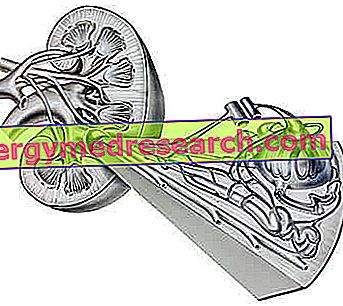Related articles: Duodenal ulcer
Definition
Duodenal ulcer is an erosion that develops in the first centimeters of the duodenum. In practice, a sort of open wound is formed, more or less deep, which affects the inner lining of the first part of the small intestine.
At the origin of the disease there is an imbalance that alters the natural defense mechanisms of the duodenal mucosa from acidic stomach juices. The duodenal ulcer, in fact, is generally accompanied by an increased gastric secretion, in turn favored by genetic factors, stress, smoking and incorrect eating habits. The duodenum, in particular, is conditioned by the continuous use of non-steroidal anti-inflammatory drugs and by the infection with Helicobacter pylori, a bacterium capable of altering the protective layer of the duodenal mucosa.
Most common symptoms and signs *
- Anemia
- Anorexia
- Intestinal Atony
- Increased appetite
- Bad digestion
- Pain in a hip
- Abdominal pain
- Chest pain
- Pain in the Navel
- Pain in the upper part of the abdomen
- Pain in the sternum
- Hematemesis
- Gastrointestinal hemorrhage
- heartburn
- Feces picee
- Abdominal swelling
- Hypovolemia
- Melena
- Nausea
- Nausea and vomiting in the early stages of pregnancy
- Weight loss
- Gastrointestinal perforation
- Peritonismo
- Inflated stomach
- tachypnoea
- He retched
- Biliary vomiting
Further indications
The most characteristic symptom of duodenal ulcer is the appearance of a burning, dull and continuous pain, located between the lower end of the sternum and the navel. It appears more easily in the fasting state and is usually attenuated by ingesting food, but relapsing 2-3 hours after meals. The pain that awakens the patient at night is frequent and is highly suggestive of a duodenal ulcer. Sometimes, other symptoms are present, such as loss of appetite, swelling, nausea and vomiting. The ulcer, if left untreated, can involve the duodenal mucosa more deeply, triggering real bleeding. This complication can cause anemia or, if it arises in an acute way, it can manifest itself more clearly, with the emission of blood through vomiting or the presence of digested blood in the faeces. The ulcer can also extend through the entire thickness of the duodenum, perforating the affected wall. They can therefore achieve infections or injuries to adjacent organs. A perforated ulcer is a condition that requires immediate medical-surgical treatment. Attention therefore to the appearance of a sudden and stabbing pain, in addition to the symptoms already described for the bleeding.
Another of the consequences that can occur is occlusion, due to inflammation and the formation of scar tissue.
From the diagnostic point of view, the duodenal ulcer is suspected on the basis of symptoms and confirmed by endoscopy (gastroduodenoscopy), mucosal biopsies, research of Helicobacter pylori infection and radiographs.
The treatment of duodenal ulcer involves the use of antacid drugs, histamine H2 receptor antagonists and proton pump inhibitors. Furthermore, the antibiotic eradication of Helicobacter pylori is essential if this bacterium is present. Surgical therapy, on the other hand, is reserved for more severe cases and complications, such as bleeding or perforations.



